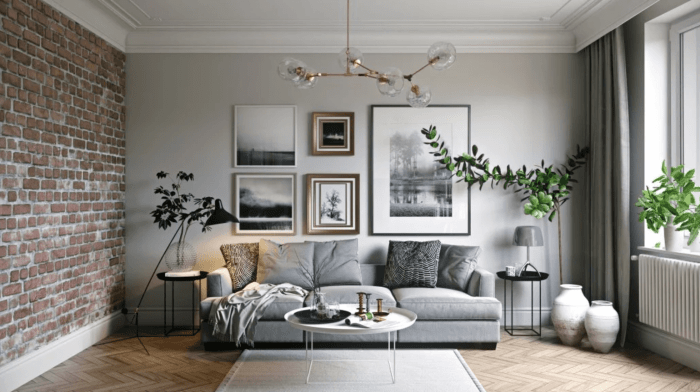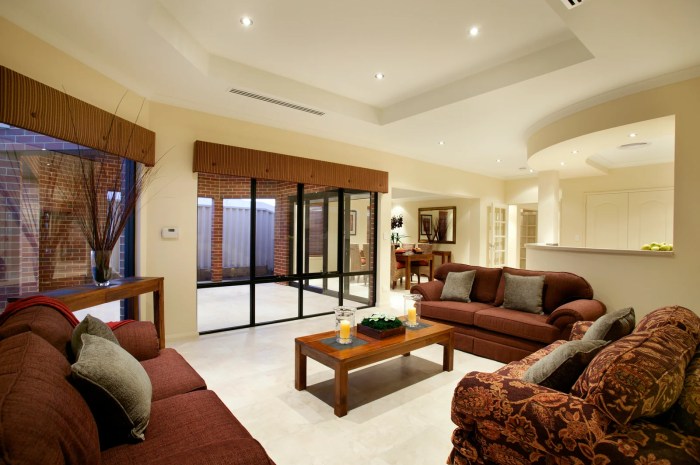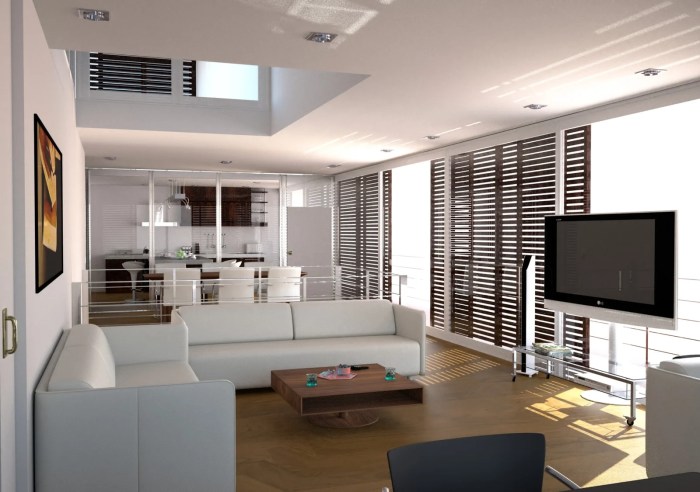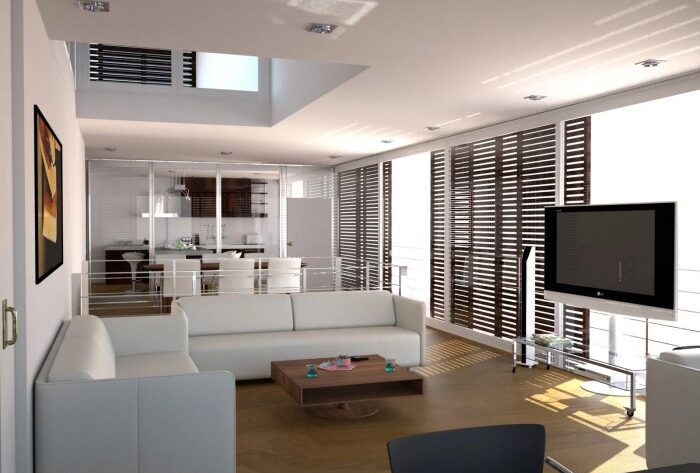Aesthetic house design interior is more than just a pretty space; it’s about creating a home that reflects your personality and inspires you. It’s about understanding the interplay of color, texture, light, and furniture to achieve a cohesive and visually appealing environment.
From minimalist chic to bohemian eclectic, the world of aesthetic house design offers a spectrum of styles to suit every taste and lifestyle.
This guide delves into the key elements that contribute to a beautiful and functional home. We’ll explore how to create a color palette that evokes the desired mood, choose materials that enhance the overall aesthetic, and incorporate furniture and décor that complement the chosen style.
We’ll also touch upon space planning, lighting, and the importance of incorporating natural elements to elevate the design.
Lighting and Natural Elements

Lighting plays a crucial role in enhancing the aesthetic appeal of a house interior. It can create ambiance, highlight architectural features, and influence the overall mood of a space. Natural elements, such as plants and greenery, can bring life and vibrancy to a minimalist aesthetic, creating a sense of harmony and connection with nature.
Lighting Design for a Minimalist Aesthetic
A minimalist aesthetic often prioritizes clean lines, simplicity, and a sense of spaciousness. Lighting design for such an interior should complement these principles. Here are some key considerations for designing a lighting plan:* Use a combination of natural and artificial light.Maximize natural light by using large windows and skylights.
Supplement with artificial lighting to create a balanced and functional environment.
- Prioritize natural light.Strategically position furniture and decor to take advantage of natural light. Utilize light-colored walls and furnishings to reflect natural light throughout the space.
- Embrace warm, soft lighting.Avoid harsh overhead lighting. Instead, opt for warm-toned LED bulbs or dimmable fixtures that create a cozy and inviting atmosphere.
- Utilize task lighting.Incorporate targeted lighting for specific areas, such as reading nooks, workspaces, or kitchen counters.
- Consider layering light.Create depth and dimension by using a combination of ambient, accent, and task lighting. Ambient lighting provides overall illumination, accent lighting highlights specific features, and task lighting provides focused illumination for specific activities.
Impact of Natural Elements
Incorporating natural elements into a minimalist aesthetic can enhance the overall visual appeal and create a sense of tranquility.* Plants and greenerybring life and vibrancy to a space. They can act as natural air purifiers and create a sense of connection with the outdoors.
- Natural materialssuch as wood, stone, and bamboo add warmth and texture to a minimalist interior. They can create a sense of grounding and balance.
- Water featuressuch as fountains or aquariums can create a calming and relaxing atmosphere. The sound of running water can also help to mask unwanted noise.
Maximizing Natural Light
Here are some examples of how natural light can be maximized in different house designs:* Open floor plansallow natural light to flow freely throughout the space.
- Large windows and skylightsprovide ample natural light, even in rooms that lack direct sunlight.
- Lightwellsare vertical shafts that bring natural light into interior spaces that are not directly exposed to sunlight.
- Mirrored surfacescan reflect natural light, making a space appear brighter and larger.
Space Planning and Functionality

Space planning and functionality are essential aspects of aesthetic house design. They ensure that the house is not only visually appealing but also practical and comfortable for its inhabitants. This involves creating a layout that optimizes space usage, flow, and functionality, while also considering the overall aesthetic vision.
Principles of Space Planning, Aesthetic house design interior
Space planning in aesthetic house design focuses on creating a harmonious balance between form and function. It involves understanding the principles of:
- Circulation: Ensuring easy and efficient movement throughout the house. This involves planning for clear pathways, avoiding obstacles, and providing adequate space for furniture and appliances.
- Proportion and Scale: Creating a sense of balance and harmony through the appropriate sizing and placement of rooms, furniture, and other elements. This involves considering the overall dimensions of the house and its individual spaces, as well as the scale of furniture and fixtures.
- Flexibility and Adaptability: Designing spaces that can be easily adapted to changing needs and lifestyles. This might involve incorporating multi-functional furniture, movable walls, or open-plan layouts that can be reconfigured over time.
Floor Plan Design for a Small House
This floor plan for a small house prioritizes functionality and aesthetics:
- Open-Plan Living Area: Combines the living room, dining area, and kitchen into a single space, maximizing natural light and creating a sense of openness. This is a popular choice for small homes, as it allows for greater flexibility and creates a more social atmosphere.
- Compact Kitchen: Features efficient layout and storage solutions, such as built-in appliances, a small island, and wall-mounted cabinets. This allows for optimal use of space while maintaining a stylish and functional design.
- Multi-Functional Bedroom: Serves as a sleeping space, home office, and potentially a guest room. This can be achieved by using furniture with multiple purposes, such as a Murphy bed or a desk that folds away when not in use.
- Minimalist Bathroom: Incorporates a compact shower, floating vanity, and a minimal amount of storage to maximize space. This creates a clean and airy atmosphere while still offering essential functionality.
Importance of Functionality in Aesthetic House Design
Functionality plays a crucial role in aesthetic house design because it ensures that the house is not only visually appealing but also practical and comfortable for its inhabitants. It involves:
- Efficient Space Utilization: Maximizing the use of available space through clever storage solutions, multi-functional furniture, and efficient layouts. This ensures that the house is not cluttered and that all areas are well-utilized.
- User-Friendly Design: Creating a space that is easy to navigate and use. This involves considering the flow of movement, accessibility, and the placement of furniture and appliances.
- Comfort and Well-being: Ensuring that the house provides a comfortable and relaxing environment. This involves considering factors such as natural light, ventilation, acoustics, and the use of comfortable materials.
Balancing Aesthetics with Functionality
Balancing aesthetics with functionality is a key challenge in aesthetic house design. Here are some examples of how to achieve this balance in different areas of a house:
- Kitchen: Incorporating a stylish backsplash with a functional countertop material, such as quartz or granite. This allows for both a visually appealing and durable work surface.
- Living Room: Choosing a comfortable sofa that also serves as a stylish focal point. This ensures that the space is both inviting and visually appealing.
- Bedroom: Using a sleek headboard that also provides built-in storage. This maximizes space and creates a cohesive and elegant look.
- Bathroom: Installing a stylish shower with a built-in niche for storing toiletries. This creates a spa-like atmosphere while also offering convenient storage solutions.
Inspiration and Trends
Aesthetic house design is constantly evolving, drawing inspiration from various sources and reflecting the changing tastes of homeowners. From iconic architectural masterpieces to contemporary design trends, the world of aesthetic house design is a rich tapestry of ideas and influences.
This section explores some of the most influential sources of inspiration and the current trends shaping the aesthetic of modern homes.
Famous Aesthetic House Designs
The following are some of the most influential aesthetic house designs and their key features:
- The Fallingwater House (Frank Lloyd Wright, 1935): This iconic house is a prime example of organic architecture, seamlessly integrating with its natural surroundings. Its cantilevered decks and use of natural materials like stone and wood create a harmonious blend of form and function. The Fallingwater House embodies a sense of unity with nature, a key element in many aesthetic house designs.
- The Villa Savoye (Le Corbusier, 1931): This modernist masterpiece showcases the principles of the International Style, emphasizing clean lines, geometric shapes, and open spaces. The Villa Savoye’s use of concrete, glass, and steel creates a minimalist aesthetic that has influenced countless modern homes. It embodies the modern movement’s focus on functionality and simplicity.
- The Farnsworth House (Mies van der Rohe, 1951): This minimalist house, situated on a riverbank, epitomizes the “less is more” philosophy. Its transparent glass walls offer panoramic views of the surrounding nature, blurring the lines between the interior and exterior. The Farnsworth House’s focus on transparency and connection to the outdoors is a recurring theme in contemporary aesthetic design.
Current Trends in Aesthetic House Design
Aesthetic house design trends are constantly evolving, driven by a combination of social, technological, and cultural influences. Here are some of the key trends that are shaping the aesthetic of modern homes:
- Biophilic Design: Incorporating elements of nature into the home is a growing trend. This approach aims to create a sense of well-being and connection with the natural world through the use of natural materials, plants, and natural light. Biophilic design can be seen in the use of wooden floors, green walls, and large windows that bring in natural light and views.
- Minimalism: This trend emphasizes simplicity, functionality, and clean lines. Minimalist homes are characterized by open floor plans, neutral color palettes, and a focus on essential furniture and decor. The goal is to create a sense of calm and spaciousness. Minimalism is a response to the increasing clutter and complexity of modern life, providing a sense of serenity and order.
- Smart Home Technology: Smart home technology is becoming increasingly integrated into aesthetic house designs. This includes features such as voice-activated lighting and appliances, automated thermostats, and security systems. Smart home technology not only enhances functionality but also contributes to the aesthetic by creating a seamless and connected living experience.
- Sustainable Design: Sustainability is becoming a key consideration in aesthetic house design. Homeowners are increasingly seeking ways to reduce their environmental impact through the use of energy-efficient appliances, recycled materials, and renewable energy sources. Sustainable design principles can be incorporated into various aspects of the home, from the materials used to the landscaping.
Social Media and Online Platforms
Social media and online platforms have a significant impact on aesthetic design inspiration. These platforms provide a vast and accessible source of inspiration, allowing homeowners to discover new trends, explore different styles, and connect with designers and other design enthusiasts.
- Visual Inspiration: Platforms like Pinterest, Instagram, and Houzz offer a wealth of images and videos showcasing various aesthetic house designs. These platforms allow users to curate their own boards and save images that inspire them, creating a visual library of ideas for their own homes.
- Community and Collaboration: Online communities and forums provide a space for homeowners to connect with designers, share ideas, and seek advice. These platforms foster a sense of community and allow homeowners to learn from each other’s experiences and preferences.
- Accessibility to Trends: Social media and online platforms play a crucial role in disseminating new trends in aesthetic house design. Designers and influencers often share their latest projects and ideas on these platforms, making it easier for homeowners to stay up-to-date on the latest trends.
Last Recap

Designing an aesthetic house interior is a journey of self-expression and creativity. It’s about understanding your personal style, incorporating elements that inspire you, and creating a space that reflects your unique identity. By embracing the principles of aesthetic design, you can transform your house into a sanctuary that’s both visually stunning and deeply personal.
Quick FAQs: Aesthetic House Design Interior
How can I make my small house look bigger?
Using light colors, mirrors, and multi-functional furniture can help create an illusion of more space in a small house.
What are some popular aesthetic house design styles?
Some popular styles include minimalist, Scandinavian, bohemian, industrial, and mid-century modern.
What is the best way to incorporate personal touches into my aesthetic house design?
Incorporate meaningful artwork, family photos, travel souvenirs, and unique furniture pieces that reflect your interests and experiences.




